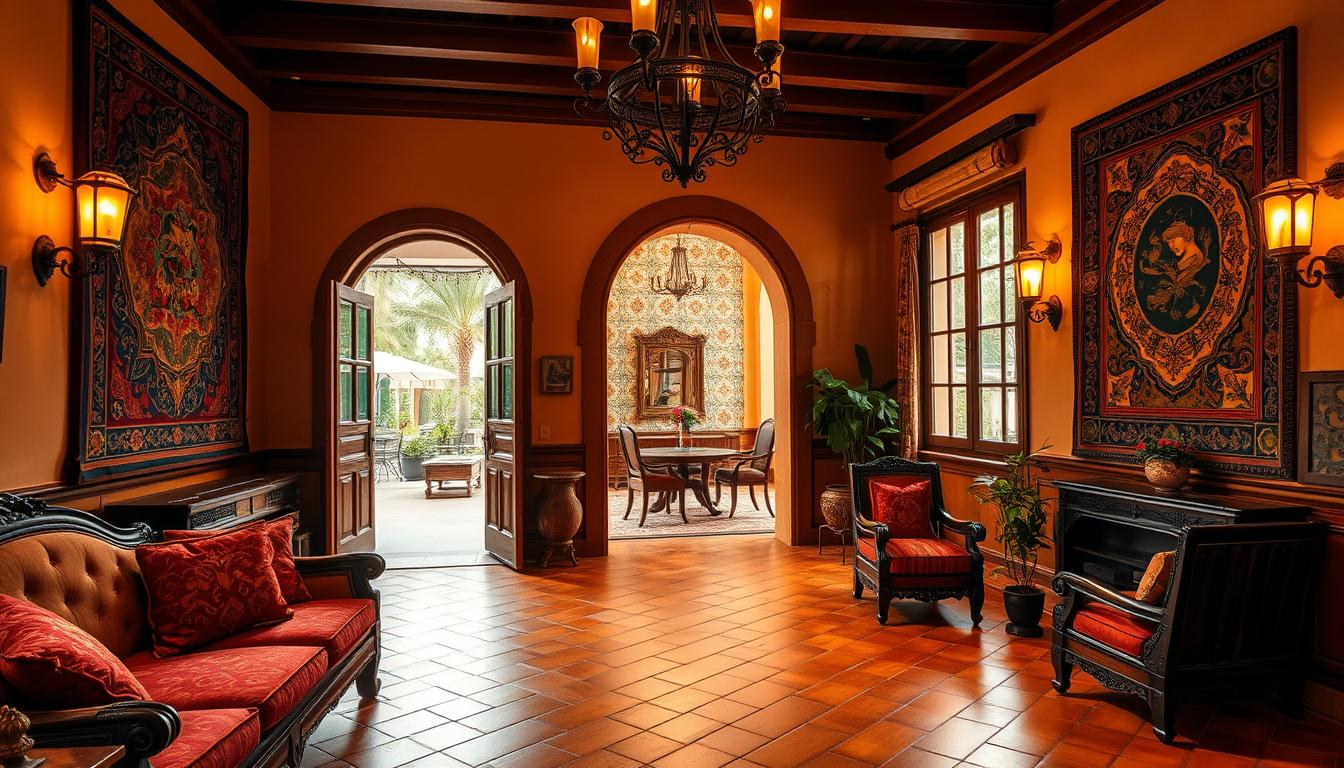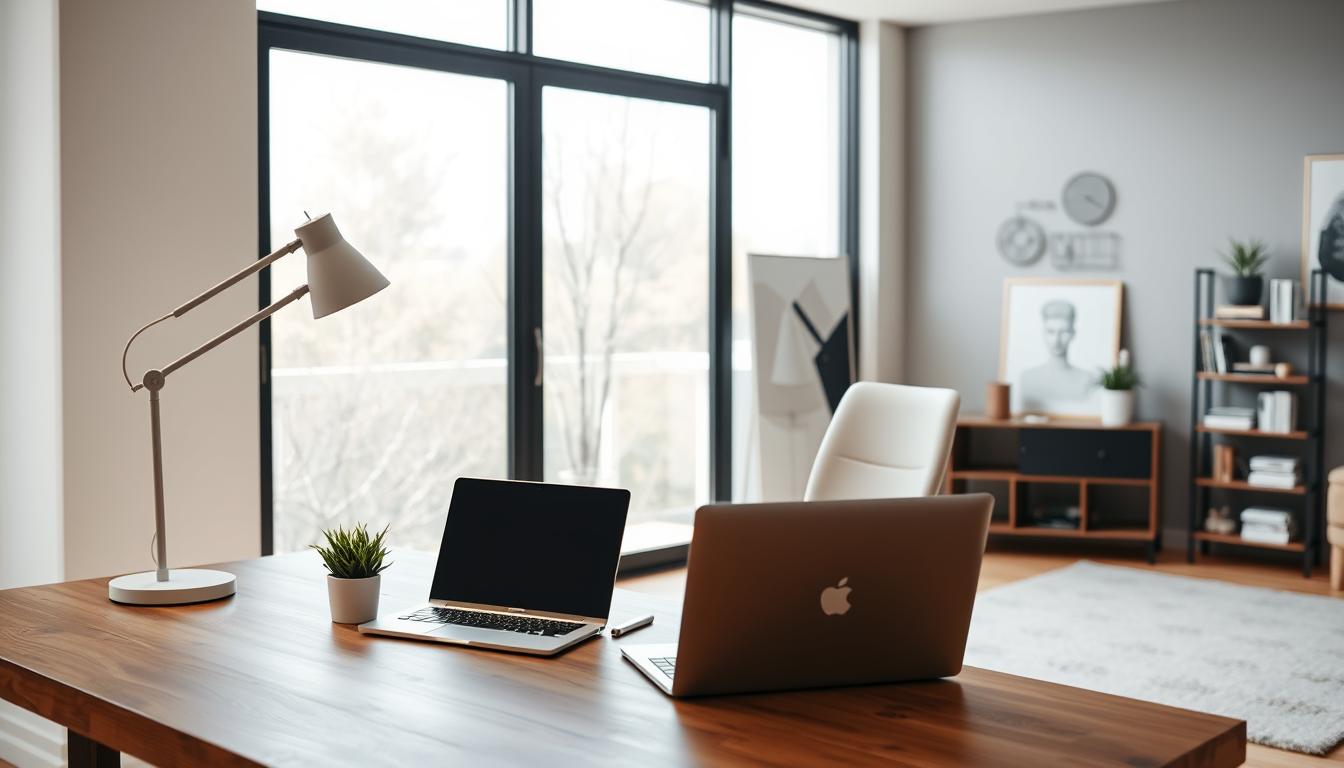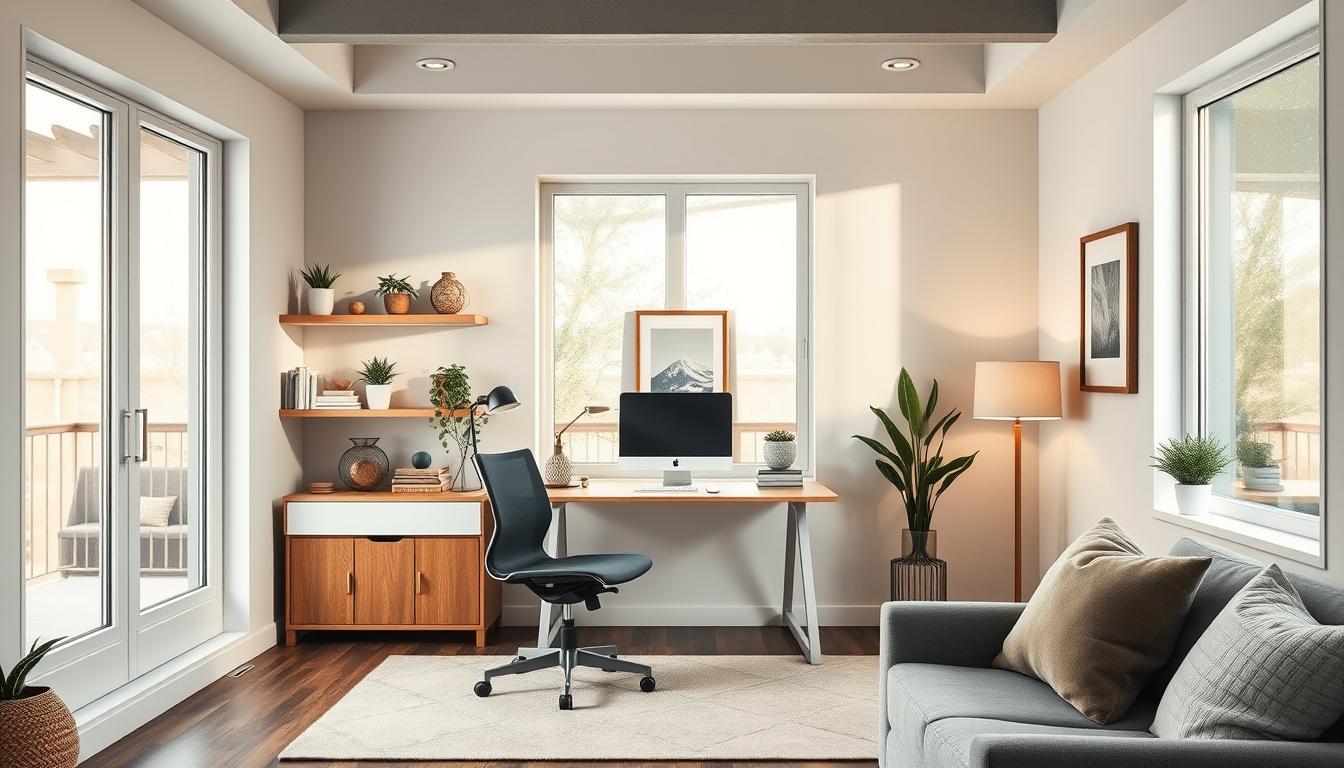Did you know homes with Spanish-style interiors are very popular in the U.S.? This style is known for its warm and welcoming look. We’ll look at what makes Spanish-style interiors so beautiful, from Spanish architecture to modern homes.
Our guide is here to help homeowners and designers make stunning Spanish-style interiors. We’ll dive into Spanish interior decor to find out how to create spaces that are both warm and elegant.
Key Takeaways
- Understanding Spanish architecture is key to designing stunning interiors.
- Mixing traditional elements with modern homes creates a unique look.
- Authenticity and function are important for beautiful Spanish interiors.
- Spanish decor is known for warm tones and detailed designs.
- Our guide offers tips for creating stunning Spanish interiors.
Understanding Spanish-Style Homes
Spanish-style homes bring the warmth of the Mediterranean into your home. They feature arches, columns, and detailed tile work. These homes celebrate Spain’s rich culture and colonial past.
Characteristics of Spanish-Style Architecture
Spanish-style homes stand out with their bold features. You’ll see curved lines, arches, and columns. They also have ornate details like intricate tile work and carved wood.
These features make the homes feel warm and welcoming. They also focus on outdoor living, with courtyards and patios.
| Architectural Element | Description | Example |
|---|---|---|
| Arches | Curved structures used to frame doorways and windows | Ornate arches above doorways |
| Columns | Tall, slender structures used to support roofs and balconies | Decorative columns on front porches |
| Tile Work | Intricately designed tiles used to adorn walls and floors | Colorful tile work in kitchens and bathrooms |
The Influence of History and Culture
Spanish-style homes are deeply connected to Spain’s history and culture. They draw from Moorish and Gothic styles, as well as the country’s colonial past.
The choice of materials like stucco, adobe, and terracotta shows the Mediterranean climate and cultural roots.
Key Elements of Design
To achieve a true Spanish-style interior, focus on warm colors, ornate tile work, and decorative textiles.
- Warm, earthy tones, such as terracotta and sienna
- Ornate tile work, including intricate designs and patterns
- Decorative textiles, such as woven baskets and embroidered fabrics
By using these elements, you can create a welcoming Spanish-style home. It will reflect Spain’s rich cultural heritage.
Color Palettes for Spanish Interiors
To capture the essence of Spanish-style homes, it’s essential to choose a color palette that reflects their warm and earthy characteristics. Spanish revival interiors are renowned for their rich, inviting atmospheres. This is largely achieved through the careful selection of colors.
Warm and Earthy Tones
The foundation of a Spanish-style color palette lies in its warm and earthy tones. These colors are reminiscent of the Spanish countryside. Shades of terracotta, sienna, and golden brown are common.
Using warm beige or soft terracotta as your primary colors is a good idea. These hues can be applied to walls, furniture, and flooring. This creates a cohesive look that is characteristic of spanish home decor ideas.
Accent Colors and Their Uses
While warm and earthy tones form the base, accent colors add depth and visual interest. Deep blues, vibrant reds, and sunny yellows are commonly used. They add a pop of color and create a lively atmosphere.
These accent colors can be introduced through various decorative elements. For example, a brightly colored rug or a few strategically placed throw pillows can significantly enhance a room’s aesthetic appeal.
Integrating Textures and Patterns
In addition to a well-chosen color palette, integrating a variety of textures and patterns is key. From the rough texture of stone walls to the intricate patterns of traditional Spanish tiles, texture adds depth and character.
To achieve this, mix different textures like wood, stone, and ceramics. Also, include various patterns like geometric tiles and woven textiles. This blend enhances visual appeal and contributes to an authentic Spanish revival interiors experience.
Furniture Choices for a Spanish Aesthetic
To get a true Spanish vibe, pick furniture that shows off the country’s rich culture. The right pieces can make your home feel warm and welcoming, just like Spanish homes.
Traditional Spanish Furniture Styles
Traditional Spanish furniture is all about fancy details, rich wood, and classic looks. It often has intricate carvings, curved shapes, and fancy metalwork. Wooden furniture, like walnut or oak, is key in Spanish interiors. It’s often decorated with carved flowers or scroll patterns.
Modern Interpretations of Spanish Design
Modern Spanish design is a new spin on old classics. It mixes clean lines, simple designs, and focus on function. This mix of old and new creates a look that’s both modern and deeply rooted in tradition.
Tips for Mixing and Matching Styles
Mixing old and new furniture styles can make your home more interesting. Here are some tips:
- Match fancy, traditional pieces with simpler, modern ones for contrast.
- Use a common element, like the same wood tone or metal finish, to link different styles.
- Feel free to add unique pieces that show your style, as long as they fit the Spanish theme.
| Furniture Style | Characteristics | Examples |
|---|---|---|
| Traditional Spanish | Ornate details, rich wood tones, classic designs | Carved wooden armchairs, intricately designed cabinets |
| Modern Spanish | Clean lines, minimal ornamentation, functional | Sleek sofas, minimalist coffee tables with metal or wood accents |
| Mixed Style | Blend of traditional and modern elements | Pairing a traditional wooden dining table with modern chairs |
By carefully choosing and mixing furniture, you can make a Spanish-style home that’s both real and uniquely yours.
Flooring Options in Spanish-Style Homes
The flooring in a Spanish-style home is key. It adds warmth and authenticity. Traditional materials reflect Spain’s rich culture.
Authentic Terracotta and Tile
Terracotta and tile are common in Spanish homes. They’re durable and timeless. Terracotta tiles add a warm, earthy feel. Ceramic tiles offer design flexibility.
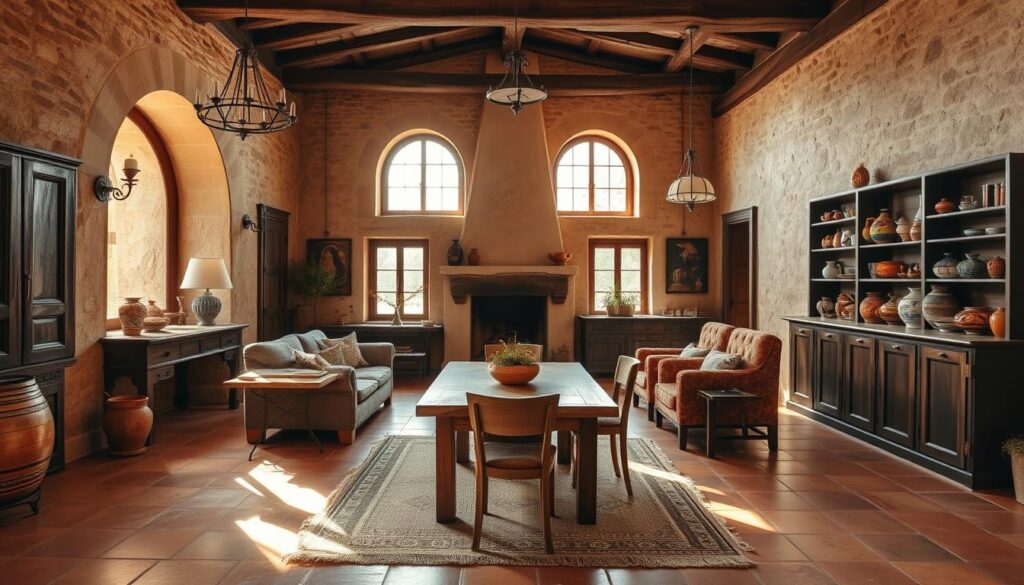
Incorporating Wood and Stone
Wood and stone are also used in flooring. Hardwood floors, with dark finishes, add elegance. Stone, like limestone or marble, brings sophistication.
Maintenance Tips for Flooring
Regular care is key for Spanish-style flooring. Terracotta and tile need sealing to protect against stains. Hardwood floors need polishing. Stone floors should be resealed occasionally.
| Flooring Type | Maintenance Needs | Durability |
|---|---|---|
| Terracotta Tile | Periodic Sealing | High |
| Hardwood | Regular Polishing | Medium to High |
| Stone (Limestone, Marble) | Occasional Resealing | High |
For more inspiration, check out our guide to crafting stunning Spanish-inspired home interiors. The right flooring and care make your home beautiful and authentic for years.
Wall Treatments That Enhance Spanish Charm
To bring the charm of Spanish interior decor into your home, think about wall treatments. The right choice can make a room feel more real and welcoming.
There are many wall treatments that can make your home feel more Spanish. Let’s look at a few that can make your walls more interesting and deep.
Textured Plaster Walls
Textured plaster walls are a key feature of Mediterranean interior design. They add depth and interest to any room. The texture can be light or bold, depending on what you want.
To get this look, plaster and aggregate are mixed and applied to the wall. This creates a unique, organic texture. It’s not just pretty; it’s also strong.
The Use of Bold Wallpapers
While Spanish interiors often stick to calm colors, bold wallpapers can bring a modern twist. Pick a design that fits your home’s style, like geometric patterns or bright colors.
For a real Spanish feel, choose a wallpaper that looks like traditional Spanish tiles or fabrics. It adds depth and interest to your walls.
Decorative Tiles as Accents
Decorative tiles are a big part of Spanish interior decor. They can be used as wall accents, adding color and interest. Use them to highlight a spot, like a backsplash or a statement wall.
For more tips on designing beautiful Spanish-style interiors, check out our guide on Spanish-style interior design.
Lighting Solutions for Warm Ambiance
Creating a warm ambiance in Spanish-style homes needs careful lighting choices. These should mix traditional charm with modern needs. The right lighting can change a room’s feel, making it key to pick fixtures that match the style.
Chandeliers and Pendant Lights
Chandeliers and pendant lights are key for a warm, inviting feel in Spanish-style homes. They often have detailed metalwork or glass, showing off Spanish colonial decor’s beauty.
A wrought iron chandelier can bring authenticity. Glass pendant lights add elegance. Make sure the size of the room and ceiling height match the fixture for a balanced look.
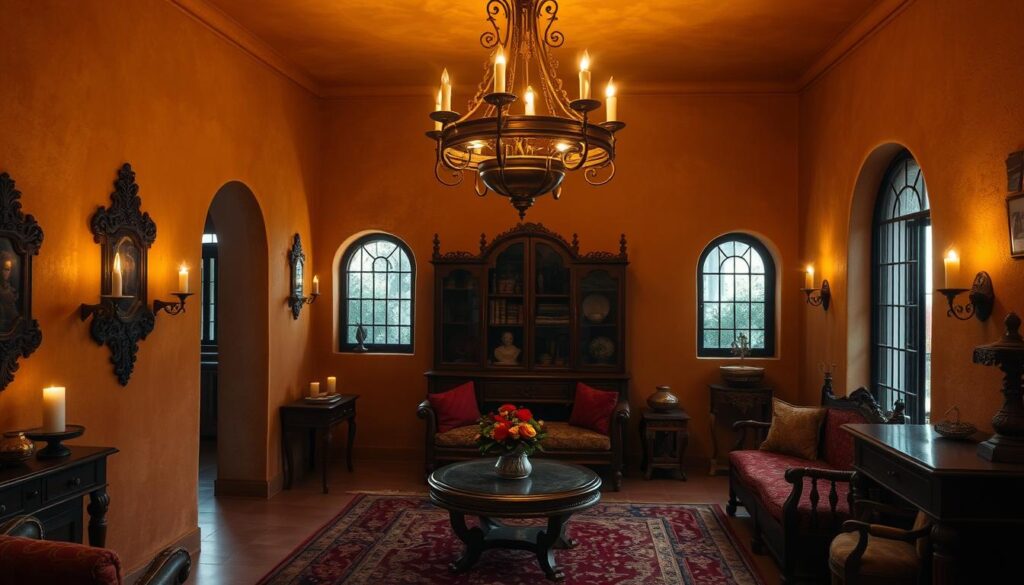
Wall Sconces and Lamps
Wall sconces and lamps add more light, making a Spanish-style home warmer. Traditional designs often use metal like bronze or copper, adding depth and character.
Choose wall sconces that match your home’s architecture. For lamps, pick those with ceramic or terracotta, fitting the earthy tones of Spanish revival interiors.
Utilizing Natural Light
Using natural light is key for a warm ambiance in Spanish-style homes. Big windows, often with ornate woodwork or wrought iron, are typical of this style.
To get the most natural light, keep windows clear. Use sheer curtains or blinds to let sunlight in while keeping privacy. This brightens the space and shows off the architecture.
| Lighting Fixture | Characteristics | Style Tips |
|---|---|---|
| Chandeliers | Intricate metalwork, ornate details | Choose based on room scale and ceiling height |
| Pendant Lights | Glass details, modern interpretations | Use to add elegance and highlight architectural features |
| Wall Sconces | Metalwork, traditional designs | Echo architectural details, add depth |
| Lamps | Ceramic, terracotta elements | Complement earthy tones, add warmth |
Art and Decor That Embody Spanish Heritage
To truly capture the essence of Spanish-style design, one must consider the role of art and decor. They reflect the country’s rich cultural heritage. Art and decor are not just aesthetic additions; they are essential in creating an authentic and inviting Spanish-style home.
Incorporating Classic Spanish Artwork
Classic Spanish artwork, including pieces from renowned Spanish artists, can add a layer of authenticity to your Spanish-style home. Consider incorporating prints or originals that reflect Spanish culture, such as works by Picasso, Dalí, or Miró. These pieces not only beautify your space but also serve as a connection to Spain’s rich artistic history.
When selecting artwork, consider the style and period that best complements your home’s design. For instance, a Baroque or Renaissance-inspired piece can enhance the classic feel of your Spanish-style interior.
Handmade Crafts and Textiles
Handmade crafts and textiles are another vital element in embodying Spanish heritage. Look for items such as hand-woven blankets, embroidered linens, and intricately crafted wooden pieces. These items bring warmth and character to your home, reflecting the artisanal traditions of Spain.
- Hand-woven baskets and rugs
- Embroidered clothing and linens
- Intricately carved wooden decorative items
Incorporating these handmade elements not only adds visual interest but also tells a story of Spain’s artisanal heritage.
Decorative Ceramics and Pottery
Decorative ceramics and pottery are hallmarks of Spanish craftsmanship. Look for pieces that reflect traditional Spanish styles, such as Talavera pottery, known for its vibrant colors and intricate designs. These pieces can be used both functionally and decoratively, adding a touch of Spanish charm to your home.
When choosing ceramics and pottery, consider the color palette and design to ensure they complement your existing decor. A well-placed vase or a decorative plate can become a focal point in a room, enhancing the overall Spanish ambiance.
By thoughtfully incorporating classic Spanish artwork, handmade crafts, and decorative ceramics and pottery, you can create a Spanish-style home that is both beautiful and rich in cultural heritage.
Outdoor Living Spaces in Spanish Homes
Creating a beautiful outdoor space is key to Spanish-style living. Outdoor areas in Spanish homes blend with the inside, making a smooth transition. This design makes the home feel more open and welcoming.
Designing Inviting Patios and Courtyards
Patios and courtyards are key in Spanish architecture. They offer peaceful spots in the home. To make a patio or courtyard inviting, think about adding:
- Terracotta tiles or stone flooring
- Ornate fountains or water features
- Lush greenery and vibrant flowers
- Comfortable seating areas
Selecting Furnishings for the Outdoors
Choosing the right outdoor furniture is important. Look for pieces that are both strong and look good. Consider:
- Wrought iron furniture with intricate details
- Weather-resistant textiles in earthy tones
- Handcrafted ceramics and pottery
These items will last long and add to the rustic beauty of your outdoor area.
Landscaping Ideas That Complement Interior Design
Landscaping is vital for Spanish-style homes. It helps tie the look of the home together. Here are some landscaping ideas:
| Landscaping Element | Description | Benefit |
|---|---|---|
| Drought-resistant plants | Plants that thrive in dry conditions | Low maintenance |
| Terracotta pots | Earthenware pots in various sizes | Adds warmth and character |
| Meandering pathways | Paths made of stone or brick | Creates a sense of exploration |
Using these landscaping ideas can make your indoor and outdoor spaces feel connected. This captures the essence of traditional Spanish interior design and rustic Spanish interior design.
Integrating Modern Amenities While Retaining Character
Modernizing a Spanish-style home doesn’t mean losing its charm. It’s about adding modern touches that enhance its beauty. We can do this by carefully choosing modern amenities that fit the home’s traditional look.
Updates Without Losing Authenticity
When updating a Spanish-style home, keeping its authenticity is key. We can do this by keeping original features like terracotta tiles and wooden beams. At the same time, we add modern elements that match these traditional parts.
Key considerations include choosing materials and finishes that match the home’s style. We also make sure new additions or changes fit well with the existing architecture.
Blend of Old and New in Spanish Design
Spanish-style homes are special because they mix old and new. By combining traditional design with modern functionality, we create spaces that are both beautiful and practical.
For example, we can pair antique furniture with modern lighting or add contemporary artwork to traditional decor. This mix adds depth and interest to the space.
Smart Home Features for Spanish Homes
Adding smart home technology to a Spanish-style home can make it more functional without losing its charm. We can install smart thermostats, lighting, and security cameras that are hidden and don’t disrupt the home’s look.
Smart home features also help make the home more energy-efficient and eco-friendly. This makes it more comfortable and better for the environment.
By balancing modern amenities with traditional charm, we can make a Spanish-style home that’s both beautiful and practical. It meets today’s needs while keeping its timeless appeal.
Selecting Textiles and Fabrics
In Mediterranean interior design, fabrics are more than just functional. They are a key part of the look and feel. The right fabrics can make a Spanish revival interior feel warm and welcoming.
Textiles are crucial in Spanish-style homes. They add depth and luxury to any room. From velvets to lace, the fabric choice greatly affects the room’s ambiance.
Importance of Rich Fabrics
Rich fabrics are a key feature of Spanish-style interiors. They bring a sense of luxury and comfort. Velvet, silk, and heavy linen are favorites for upholstery and drapery.
These fabrics feel luxurious and create a cozy atmosphere. They’re perfect for relaxing in style. Adding rich fabrics to your design adds sophistication to your Spanish-style interior.
Choosing the Right Patterns and Colors
When picking textiles for a Spanish-style interior, choose patterns and colors that honor the region’s culture. Traditional Spanish patterns often include Moorish motifs and floral designs. These add visual interest to a room.
| Pattern Type | Common Colors | Typical Use |
|---|---|---|
| Moorish Motifs | Earth tones, blues, and golds | Upholstery, drapery |
| Floral Patterns | Soft pastels, whites, and creams | Bedding, curtains |
| Geometric Patterns | Bold reds, blacks, and whites | Accent pillows, rugs |
Layering Textiles for Comfort
Layering textiles is key for a cozy Spanish-style interior. Mixing different textures and patterns adds depth and interest.
For example, layer a velvet sofa with linen throw pillows and a wool blanket. This creates a cozy seating area. It adds comfort and visual appeal.
Personalizing Your Spanish-Style Interior
As we wrap up our guide to stunning Spanish-style interiors, remember that a home’s beauty comes from personal touches. We can make our Spanish-style home unique by adding elements that show our personality and style.
Adding Heirlooms and Treasures
Adding personal heirlooms and treasures to our Spanish-style home decor adds depth and character. Family pieces, antique furniture, and vintage decor blend well with modern Spanish interior design.
Customizing Unique Spaces
Every home has special spaces. Custom solutions help make the most of these areas. By using traditional Spanish interior design, we can create a unified look that ties everything together.
Signature Touches
To make our Spanish-style home special, we can add unique touches that show our personal style. This might include statement pieces, bold artwork, or unique decorative elements that highlight our individuality.
By adding these personal elements, we can create a Spanish-style home that is not just beautiful but also meaningful and reflects our personal taste.
